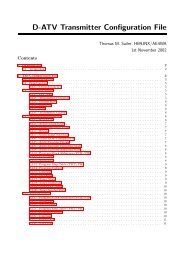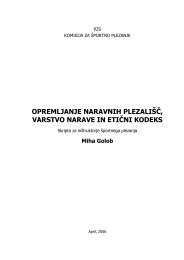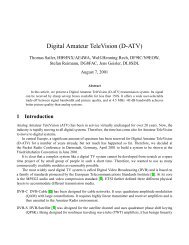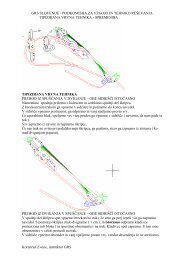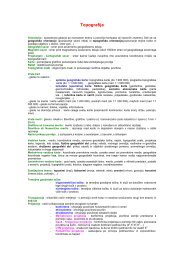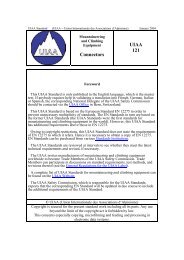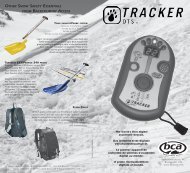A Newsletter for Friends of the CAIC
A Newsletter for Friends of the CAIC
A Newsletter for Friends of the CAIC
- No tags were found...
Create successful ePaper yourself
Turn your PDF publications into a flip-book with our unique Google optimized e-Paper software.
Monkey Businesscontinued from page fiveor affected <strong>the</strong> road in decades. Many had takendestroyed stands <strong>of</strong> mature timber. On Coal BankPass, a new building that housed cellular phone equipmentwas completely destroyed and buried under sixfeet <strong>of</strong> avalanche debris. County road 110 towardSilverton Mountain Ski Area had been struck by fifteenavalanches. Power lines that feed <strong>the</strong> ski area hadbeen ripped out. On Highway 550, 42 natural avalanchesand 32 mitigated avalanches hit <strong>the</strong> road.West Riverside put 30 feet <strong>of</strong> snow on <strong>the</strong> highway,and in all over 11,000 feet <strong>of</strong> roadway was affected bydebris. Coal Bank tipped <strong>the</strong> scale again with a grandtotal <strong>of</strong> 91 inches <strong>of</strong> snowfall and nearly 10 inches <strong>of</strong>water. By months end we calculated that this was <strong>the</strong> wettestJanuary on record!And so ends <strong>the</strong> storm story. Silverton continued digging out<strong>for</strong> days. Record snowfall was <strong>the</strong> talk <strong>of</strong> <strong>the</strong> county and madenational news. Once <strong>the</strong> roads were opened, rat-trapped localsand visitors alike lined up, anxious to make <strong>the</strong> mass exodus outWorking to clean up avalanche debris on Colorado 110 (Photo: Susan Hale)<strong>of</strong> town and escape a week <strong>of</strong> isolation. When <strong>the</strong> gate wasopened, we pulled our CDOT truck over to watch <strong>the</strong> parade. Tomy surprise and disbelief, <strong>the</strong> last vehicle to move through <strong>the</strong>barrier was a loaded down, tired, old rambler, driven by a dark,mysterious-looking woman. In <strong>the</strong> seat next to her was a small,gangly, round eyed creature. The MONKEY? Naah! !Spencer Logan,AvalancheForecasterby Scott Toepfer, Forecaster, <strong>CAIC</strong>-BoulderLast year <strong>the</strong> <strong>CAIC</strong> hired its first new <strong>for</strong>ecaster inmore than 10 years. Knox knew he was retiringand felt it would be a good idea to bring in a newemployee so <strong>the</strong>y’d be com<strong>for</strong>table with <strong>the</strong> job, andhopefully take a little pressure <strong>of</strong>f <strong>the</strong> new director.Spencer has fit in to our little <strong>of</strong>fice much better thanexpected. He’s brought a great ‘outside <strong>the</strong> box’ viewto our daily <strong>of</strong>fice routine.Spencer comes to us with a strong background in snow andtraveling about <strong>the</strong> backcountry. His first backcountry experiencewas at around 11 years old, skiing <strong>of</strong>f <strong>of</strong> Trail Ridge Road in RockyMountain National Park. He attended <strong>the</strong> National AvalancheSchool while a senior in high school, which might make him <strong>the</strong>youngest student to have gone through <strong>the</strong> program. At <strong>the</strong> NASKnox was his first instructor on <strong>the</strong> broader points <strong>of</strong> mountainwea<strong>the</strong>r, and orographics became one <strong>of</strong> his favorite words.Spencer is now able to ponder <strong>the</strong> mysteries <strong>of</strong> <strong>for</strong>ecastingorographic snowfalls every week in our Boulder <strong>of</strong>fice.Early on in his life he triggered his first avalanche when acornice broke <strong>of</strong>f right at his toes. He remembers thinking “Thisstuff is pretty cool!” His second close encounter got him caughtup in a moving avalanche, which he didn’t find so cool, as hefought and struggled to stay at <strong>the</strong> top <strong>of</strong> <strong>the</strong> debris. With a soreknee and an angry conversation with himself <strong>the</strong> only injuries, heconsidered himself extremely lucky. He also knew he had to learnmore about <strong>the</strong> science <strong>of</strong> slabs over weak layers.Spencer spent his early years in <strong>the</strong> Fort Collins/La Porte area<strong>of</strong> nor<strong>the</strong>rn Colorado. His parents were keen on skiing so Spencerlearned <strong>the</strong> life style at <strong>the</strong> old Hidden Valley skiarea near Rocky Mountain National Park. Sincehis dad, Jesse, works as a research scientistwith <strong>the</strong> US Forest Service, Spencer, his mo<strong>the</strong>rBronwyn, a librarian, and his one bro<strong>the</strong>r Tyler,traveled to places like New Zealand and Virginiafollowing his Dad’s career. Education andresearch seem to run in his family. With researchand books playing an important part in hisupbringing, an advanced education just seemedlike <strong>the</strong> thing to do.His snow education continued with an undergraddegree from Utah State University, with asenior <strong>the</strong>sis compiling an avalanche atlas <strong>of</strong>high use backcountry areas. Spencer recentlywrapped up his masters degree from MontanaState University, his <strong>the</strong>sis <strong>the</strong>re was titledTemporal Change in Spatial Variability <strong>of</strong> ShearStrength and Stability over Uni<strong>for</strong>m Slopes. In<strong>the</strong> process <strong>of</strong> his masters Spencer told me “I hadto dig way too many snowpits, and pulled more than 1000 shearframes. That’s a lot <strong>of</strong> time with your head buried in <strong>the</strong> snow.”What he came away with were some really scary spatial variabilitystatistics. This background has contributed valuable knowledge,which is an added help while writing out <strong>the</strong> daily <strong>for</strong>ecast at<strong>the</strong> <strong>CAIC</strong>.One <strong>of</strong> <strong>the</strong> best ways to learn about <strong>the</strong> art and science <strong>of</strong>snow is to work as an avalanche <strong>for</strong>ecaster. After putting in manyvolunteer hours at <strong>the</strong> Bear River Avalanche Forecast Office inLogan, Utah, he finally got hired on as a fulltime <strong>for</strong>ecaster, andspent three years rating avalanche danger <strong>for</strong> a popular backcountryarea <strong>of</strong> Utah. Now he feels he has finally grown out <strong>of</strong><strong>the</strong> high-risk years, and can get on with <strong>the</strong> life <strong>of</strong> a pr<strong>of</strong>essionalavalanche <strong>for</strong>ecaster.Spencer tied <strong>the</strong> knot with his wife Brandy not long ago.Brandy, following in <strong>the</strong> Logan footsteps, is close to finishing hermasters degree in fluvial geomorphology, <strong>the</strong> study <strong>of</strong> how riversare shaped, and how that affects fish habitat.In twenty years Spencer can see himself skiing waist deeppowder in an undisclosed location. I suspect he’ll do so wisely. !Spencer Logan after a goodday <strong>of</strong> snowpits and turns.(Photo: Spencer Logancollection)6The Beacon, Winter 2006 ! Volume 10, Number 2






